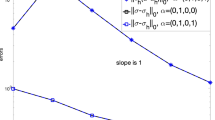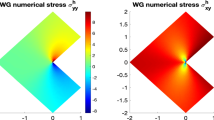Abstract
The present paper develops a new type of hybrid finite element model with regular and special fundamental solutions (also known as Green’s functions) as internal interpolation functions for analyzing plane elastic problems in structures weakened by circular holes. A variational functional used in the proposed model is first constructed, and then, the assumed intra-element displacement fields satisfying a priori the governing partial differential equations of the problem under consideration is constructed using a linear combination of fundamental solutions at a number of source points outside the element domain, as was done in the method of fundamental solutions. To ensure continuity of fields over inter-element boundaries, conventional shape functions are employed to construct the independent element frame displacement fields defined over the element boundary. The linkage of these two independent fields and the element stiffness equations in terms of nodal displacements are enforced by the minimization of the proposed variational functional. Special-purpose Green’s functions associated with circular holes are used to construct a special circular hole element to effectively handle stress concentration problems without complicated local mesh refinement or mesh regeneration around the hole. The practical efficiency of the proposed element model is assessed via several numerical examples.
Similar content being viewed by others
References
Pian THH (1964) Derivation of element stiffness matrices by assumed stress distribution. AIAA J 2: 1333–1335
Qin QH (2000) The Trefftz finite and boundary element method. WIT press, Boston
Qin QH, Wang H (2008) Matlab and C programming for Trefftz finite element methods. CRC Press, New York
Piltner R (2008) Some remarks on hybrid-Trefftz finite elements with elliptic holes. Finite Elem Anal Des 44: 767–772
Jirousek J, Venkatesh A (1992) Hybrid-Trefftz plane elasticity elements with p-method capabilities. Int J Numer Meth Eng 35: 1443–1472
Freitas JAT, Bussamra FLS (2000) Three-dimensional hybrid-Trefftz stress elements. Int J Numer Meth Eng 47: 927–950
Qin QH (1995) Hybrid Trefftz finite element method for Reissner plates on an elastic foundation. Comput Meth Appl Mech Eng 122: 379–392
Jirousek J, Wroblewski A, Qin QH, He XQ (1995) A family of quadrilateral hybrid-trefftz p-elements for thick plate analysis. Comput Meth Appl Mech Eng 127: 315–344
Qin QH (1994) Hybrid Trefftz finite element approach for plate bending on an elastic foundation. Appl Mathe Model 18: 334–339
Qin QH (1996) Transient plate bending analysis by hybrid Trefftz element approach. Comm Numer Meth Eng 12: 609–616
Freitas JAT (1997) Hybrid-Trefftz displacement and stress elements for elastodynamic analysis in the frequency domain. Comput Assis Mech Eng Sci 4: 345–368
Jirousek J, Qin QH (1996) Application of hybrid-Trefftz element approach to transient heat conduction analysis. Comput Struct 58: 195–201
Qin QH (1995) Postbuckling analysis of thin plates by a hybrid Trefftz finite element method. Comput Meth Appl Mech Eng 128: 123–136
Qin QH (2005) Formulation of hybrid Trefftz finite element method for elastoplasticity. Appl Mathe Model 29: 235–252
Leconte N, Langrand B, Markiewicz E (2008) Toward a Hybrid-Trefftz element with a hole for elasto-plasticity?. J Comput Appl Math 218: 88–95
Qin QH (2003) Variational formulations for TFEM of piezoelectricity. Int J Solid Struct 40: 6335–6346
Wang H, Qin QH, Arounsavat D (2007) Application of hybrid Trefftz finite element method to non-linear problems of minimal surface. Int J Numer Meth Eng 69: 1262–1277
Wang H, Qin QH (2009) Hybrid FEM with fundamental solutions as trial functions for heat conduction simulation. Acta Mech Solida Sin 22: 487–498
Wang H, Cao LL, Qin QH (2010) Hybrid graded element model for nonlinear functionallly graded materials. Mech Adv Mater Struct, accepted for publication
Wang H, Qin QH (2010) Fundamental-solution-based finite element model for plane orthotropic elastic bodies. Eur J Mech Solid/A 29: 801–809
Muskhelishvili NI (1963) Some basic problems of the mathematical theory of elasticity, 4th edn. Noordhoff, Netherlands
Brebbia CA, Telles JCF, Wrobel LC (1984) Boundary element techniques. Springer-Verlag, Berlin
Tang SG, Cao ZY (1998) Complex fundamental solutions for semi-infinite plane and infinite plane with hole under various boundary conditions. Appl Math Mech 19: 335–344 (in Chinese)
Kupradze VD, Aleksidze MA (1964) The method of functional equations for the approximate solution of certain boundary value problems. USSR Comput Math Math Phys 4: 82–126
Wang H, Qin QH (2008) Meshless approach for thermo-mechanical analysis of functionally graded materials. Eng Anal Bound Elem 32: 704–712
Wang H, Qin QH, Kang YL (2006) A meshless model for transient heat conduction in functionally graded materials. Comput Mech 38: 51–60
Zhang JM, Yao ZH, Tanaka M (2003) The meshless regular hybrid boundary node method for 2D linear elasticity. Eng Anal Bound Elem 27: 259–268
Sze KY, Liu GH, Fan H (2010) Four- and eight-node hybrid-Trefftz quadrilateral finite element models for helmholtz problem. Comput Meth Appl Mech Eng 199: 598–614
Simpson H, Spector S (1987) On the positivity of the second variation in finite elasticity. Arch Ration Mech Anal 98: 1–30
Mitic P, Rashed YF (2004) Convergence and stability of the method of meshless fundamental solutions using an array of randomly distributed sources. Eng Anal Bound Elem 28: 143–153
Berger JR, Karageorghis A (2001) The method of fundamental solutions for layered elastic materials. Eng Anal Bound Elem 25: 877–886
Author information
Authors and Affiliations
Corresponding author
Rights and permissions
About this article
Cite this article
Wang, H., Qin, QH. Fundamental-solution-based hybrid FEM for plane elasticity with special elements. Comput Mech 48, 515–528 (2011). https://doi.org/10.1007/s00466-011-0605-6
Received:
Accepted:
Published:
Issue Date:
DOI: https://doi.org/10.1007/s00466-011-0605-6




